For people, coughing is one of the most common medical complaints. In fact, it accounts for 30 million clinical visits per year.
Guess what? It is also common for cats to visit the vet for coughing too. There are a variety of diseases that can cause a cat to cough — it isn’t always them trying to hack up a hairball.
Understanding what the causes of coughing in cats are will help you recognize when it is time to seek veterinary care.
Note: If your cat is coughing persistently, having issues breathing, and/or their gums are bluish, seek veterinary care immediately.
Skip to section:
What Is a Cough?
A cough is a vital reflex action used to clear the throat and breathing passages from irritants, mucus, germs, foreign particles, and fluid. Air is suddenly, noisily, and rapidly expelled from the lungs.
Retching and vomiting stomach contents can occur when cats have severe coughing episodes.
Based on this explanation of a ‘cough,’ it is understandable why cat owners often think their cats are ‘coughing up hairballs,’ especially with all the retching and gagging that often accompanies it. But in reality, they are vomiting. Keep in mind, however, that if your cat is ‘coughing up hairballs, ’ it may still be necessary to take your cat to the veterinarian as it can indicate other problems.
The video below shows how difficult it is to differentiate between a “real cough” and a cat “coughing up” a hairball.
As you can see in the video, to cough, the cat has stopped any activity, extends its neck to stick out its head. When ‘coughing up’ a hairball, cats generally start by retching from the stomach or gagging.
They act more like they are dry heaving and preparing to vomit.
What Causes Cats to Cough?
Before we get into the list of causes, occasional coughing is completely normal. You don’t need to rush your cat to the vet, especially if they are in good health and aren’t bringing up mucus when coughing.
It is important to seek veterinary care for your cat if:
- The cough persists for more than a couple of days
- It is severe
- It causes your cat to bring up mucus or phlegm
- It is reoccurring
- It is associated with other symptoms (sneezing or wheezing), or your cat seems sick
- It is associated with weight loss
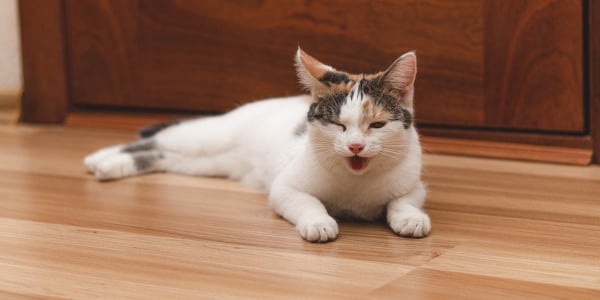
There are a number of reasons that could be causing your cat to cough.
Causes of coughing in cats include:
Respiratory Infections (viral, bacterial, or fungal)
Respiratory infections are quite common in cats since they are highly contagious. Between 80 and 90% are viral, and about 10% are bacterial. Fungal infections occur as well but are much less common.
Cats that are more suspectable to respiratory infections include:
- Kittens
- Senior cats
- Unvaccinated cats
- Outdoor cats
- Immunocompromised cats
- Cats with feline leukemia virus (FeLV) or feline immunodeficiency virus (FIV)
- Cats with other illnesses
- Cats on medications, such as steroids that can suppress their immune system
Respiratory infections that affect the lower respiratory tract can cause symptoms such as coughing, lethargy, lack of appetite, and breathing issues.
Foreign Objects
Foreign objects (a piece of food, part of a toy, etc.), both inhaled or swallowed, can cause cats to cough.
Your cat will attempt to remove the object by coughing and/or sneezing. But in some cases, the object can become lodged in such a way that they can’t remove it, and veterinary assistance is required.
Seek veterinary care immediately if you notice your cat is coughing, in distress and/or having difficulty breathing.
Heartworm Disease
Cats can get heartworm disease, though it is quite different than that of dogs. Since cats are not the typical host for heartworms, the majority of worms do not reach the adult stage. Dogs can have several hundred worms, whereas cats typically have one to three adult worms, which makes diagnosis difficult. Cats can have immature worms, which can cause significant damage.
Cats can develop a condition known as heartworm-associated respiratory disease (HARD). Symptoms of this condition include coughing, difficulty breathing, lethargy, decreased appetite, weight loss, vomiting, diarrhea, collapse, and sudden death. Unfortunately, these symptoms can mimic those of other respiratory or gastrointestinal diseases.
Since there is no treatment for heartworm disease in cats, prevention is the only way to protect them.
Unlike dogs, heart disease in cats is not commonly associated with coughing.
Cancer or Tumors
The respiratory tract of a cat can be affected by cancer, though it isn’t very common. Tumors can develop in the lungs, throat, or nose and result in coughing. Coughing isn’t a typical symptom of oral cancer, which is more common.
Primary lung tumors (originating in the lung) are very rare in cats as compared to dogs. Metastatic lung disease (tumors from somewhere else in the body that spread to the lungs) occurs more commonly than primary lung tumors. Symptoms of either type include poor appetite, weight loss, and difficulty breathing. Coughing is an uncommon symptom in cats with primary or metastatic lung tumors.
Cancer in the throat region can cause difficulty breathing when inhaling or active breathing that is noisy and high-pitched, voice changes, and coughing.
Cancer in the nose can cause a persistent cough, nasal discharge, bloody nose, excessive sneezing, rubbing or pawing at the face, facial changes, weight loss, and seizures.
Feline Asthma
Between 1 and 5% of cats are affected by asthma. Cats between the ages of 4 and 5 years are the average age at which asthma is diagnosed.
Asthma results when inhaled allergens, such as pollen, mold, dust mites, smoke, perfumes, etc., trigger an allergic reaction and cause inflammation of the airways.
One of the main symptoms of asthma is coughing. Other symptoms include wheezing, rapid breathing, difficulty breathing, hacking, open-mouthed breathing, vomiting, and lethargy.
Allergies
Environmental allergies include those to pollen, grass, fungi, mold, dust, smoke, cleaners, etc. Cats are prone to coughing if they suffer from environmental allergies.
Other symptoms of environmental allergies include skin issues (red, dry, or flaky skin, itching), swollen paws, excessive grooming, ear infections, snoring, itchy and runny eyes, vomiting, and diarrhea.
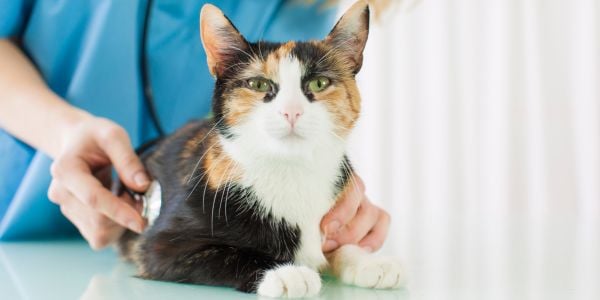
How Is the Cause of a Cough Diagnosed?
Since the causes of a cough all have similar symptoms, determining the underlying cause generally requires more than one diagnostic test.
It is important to provide your veterinarian with a detailed medical history. This should include:
- when the coughing started,
- how it has progressed and changed,
- any changes to the environment, and
- any other symptoms noted since onset.
Based on your cat’s medical history and an examination of your cat, your veterinarian will recommend several diagnostic tests. Such tests may include blood work (complete blood count (CBC), chemistry, heartworm test), chest and/or nasal x-rays, laboratory cultures of secretions from the respiratory tract, and ultrasound.
Your veterinarian may also recommend more extensive tests such as allergy testing, bronchoscopy (scoping the lungs), rhinoscopy (scoping the nose), or CT scan.
How Is a Cough Treated?
The treatment and management of your cat’s cough depends on the cause and other presenting symptoms.
Respiratory Infections
Respiratory infections caused by viruses generally involve treating the symptoms. This can include decongestants, cough suppressants, eye medications, nasal sprays, as well as antibiotics. While the antibiotic doesn’t treat the virus, it is used to treat or prevent secondary bacterial infections.
Those infections caused by bacteria are treated with antibiotics that are effective against those diseases, as well as any other symptoms similar to viral infections.
Fungal infections are treated for several weeks to months with antifungal medications. Additionally, some require treatment with antibiotics as well. In some cases, hospitalization for supportive care and oxygen therapy is necessary.
Read more if your cat has been diagnosed with an upper respiratory infection.
Foreign Objects
If your cat is unable to remove the object after a few coughs, treatment is necessary. Since your cat is likely panicked due to the presence of the object, the safest course of action is to take them to a veterinarian to have it removed under sedation or anesthesia.
Note: If you attempt to remove a foreign object from your cat’s mouth or throat, use extreme caution so that you do not get bitten. If you are bitten, you should have the area checked by a doctor.
Depending on the type of object and location, removal may require surgery.
Heartworm Disease
There are no approved drugs for treating heartworm disease in cats, and the medications used to treat heartworm disease in dogs can’t be used safely since they can cause serious side effects.
Cats who are showing no signs but are positive for heartworm disease are typically monitored closely until the natural elimination of the infection occurs. It takes three to four months after infection for most heartworms to die.
If a cat is sick due to heartworm disease, treatment is directed at managing the symptoms until the worms die. Treatment can last for several months.
Some cats are treated with prednisone to decrease inflammation and scarring of the lungs.
Cats in crisis require hospitalization, oxygen therapy, corticosteroids, and supportive care. Diuretics to remove fluid from their lungs may also be needed. In some cases, surgical removal of the worms is necessary.
Cancer
Treatment of cancer in a cat’s respiratory tract is dependent on the type of tumor, its location, and the extent of the disease.
Treatment can involve surgical removal, chemotherapy, radiation, or a combination of these.
Feline Asthma
There is no cure for feline asthma.
Treatment is generally multimodal therapy involving inhalers, pills, injections, and the avoidance of allergy triggers when possible.
To learn about cat asthma, read our article on What Causes Cat Asthma and How to Treat It.
Allergies
Treatment for food allergies involves putting your cat on a strict, novel diet and avoiding foods known to cause a reaction.
Environmental allergies can be challenging, as pinpointing what triggers a cat can sometimes be difficult.
Treatment for environmental allergies can include corticosteroids, medications (e.g., antibiotics and shampoos) to treat the skin and hair, immunosuppressive drugs, immunotherapy, antihistamines, and supplements. Avoidance of triggers, if known, is also recommended.
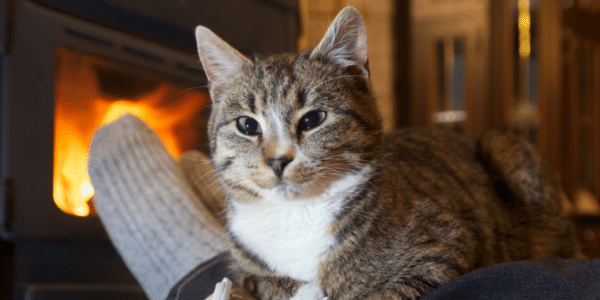
At-home Ways to Help Ease Coughing and Lessen Triggers
There are some simple steps you can take in your home to help your cat when they are coughing and decrease triggers to coughing.
Change or Clean Your Furnace Filter
Central heating systems can circulate and recirculate dust, dander, and other respiratory irritants, especially when we first turn them on after a long, hot summer.
Check out this easy-to-follow step-by-step guide from Consumer Reports or this brief YouTube video.
Frequently Vacuum and Clean Carpets
This decreases dust, pollen, dust mites, dander, and other allergens that may be present.
For cats with significant allergies or those with asthma, it might be easier and best just to remove carpets since they act like a trap for many pollutants.
Add a Room Humidifier
This can help to prevent dehydration of the cells that line your cat’s respiratory tract.
Cool-mist humidifiers are safer than hot or steam humidifiers since there is no risk of pets being burned (or you).
While both types of humidifiers add moisture (humidity) to the air, the cold produced by a cool-mist humidifier can help shrink irritation and inflammation in the nasal passages – similar to what an ice pack would do for inflamed muscles. The cool mist can ease the cough and congestion too.
Preventive Vet team member Mia uses the Raydrop cool mist humidifier, seen in the video below, for her two smush-faced pets (Pug and Exotic Shorthair cat). It's quiet, and they love to sit in front of it.
It helps them whenever they're suffering from congestion. Your pet doesn't have to be directly in front of the mist for it to be beneficial. As long as the humidifier and your pet are in a small room, they will benefit from the mist.
Be sure to routinely and properly clean and disinfect your humidifier, regardless of the type, since they are prone to mineral buildup and they can grow bacteria and mold, which, if present, will be dispersed into the air when it is used.
Our teammate uses the iClean® mini to clean hers, and she says the Raydrop is so easy to clean, unlike other humidifiers she's used in the past. Because the iClean mini only uses ozone-infused water, it doesn't introduce any harmful scents or irritants into the system or air.
Add a Room or Home Air Purifier
Before the allergens have a chance to accumulate and spread through your home, an air purifier helps to remove them. Reducing your cat’s exposure to potential triggers decreases the likelihood of reactions.
Some of our teammates in Seattle, Washington, use this air purifier, which has greatly helped with the smoke from forest fires. They really like the air quality sensor that indicates if the air is clean or dirty.
Warning:This filter has an ION setting. It’s recommended you don’t activate it – those of us who use it don't. While there are only a few studies regarding ion-producing purifiers, peer-reviewed research studies indicate that they may cause more harm with little benefit. Per the EPA, under certain use conditions,lung irritants can be produced well above levels that are considered to be harmful to people's health. They have been found to lead to increases in oxygenated VOCs and toluene. Exposure to these compounds has been linked to multiple health issues, such as irritation to the eyes, nose, and throat, headaches, liver, kidney, and central nervous system damage, and nausea. Some of the organics have been found to cause cancer in animals and people.
This purifier is a good one for use in smaller areas or on desktops.
You can also use bamboo charcoal bags in rooms, closets, cars, etc., to help purify the air. Just make sure your pets don't find the bags and break them open.
Have Your HVAC Ductwork Cleaned
This one is definitely more involved and more expensive, as you’ll need to get a professional service provider in. But it might help, depending on how old your HVAC unit is and if/when the ductwork was last cleaned.
Use Dust-free Litter
Cats spend a fair amount of time in their litter box and are exposed to a lot of dust when they are digging around in them. This is especially true for covered boxes. Switching to a dust-free or low-dust litter can significantly help cats with respiratory issues.
For dust-free litter options, read our recommendations here.
Why You Should Not Give Over-the-Counter Cough Medications to Your Cat
Some human cough medications may contain the artificial sweetener xylitol. While xylitol isn’t as toxic to cats as it is dogs, there has been reports of cats having adverse reactions to it.
Acetaminophen is in some tablet and liquid cough medications, such as Theraflu, Dayquil, Nyquil, Robitussin Daytime Severe Cough Flu and Sore Throat and Tylenol. It is highly toxic to cats.
Symptoms of acetaminophen toxicity in cats include:
- Increased heart rate
- Increased respiratory rate
- Pale gums
- Low body temperature (hypothermia)
- Loss of appetite
- Vomiting
- Swollen face and paws
- Excessive salivation
- Diarrhea
- Coma
- Death
Phenylephrine, pseudoephedrine, and ephedrine are decongestants in such products as Mucinex-D, Sudafed and Claritin-D. These medications act as stimulants that can cause an increased or irregular heart rate, hyperactivity, increased blood pressure, dilated pupils, agitation, and possibly seizures.
Symptoms can start as soon as 15 to 30 minutes after ingestion. The toxic threshold for phenylephrine has not been established but seek treatment for any accidental exposure. For pseudoephedrine and ephedrine, symptoms of toxicity have been noted with doses of 5–6 mg/kg body weight. Ingestion of doses of 10–12 mg/kg body weight can result in death. For example, a dose of greater than 2.2 mg would be toxic for a cat up to 10 lbs.
“Natural” cold and flu medications can also be toxic to cats. For example, many ‘natural’ remedies contain zinc and/or elderberry, which can be toxic to cats.
Cough drops are a choke hazard to cats and may contain toxic ingredients.

It's important to have all coughing cats evaluated by a veterinarian. Regardless of the underlying cause of your cat’s cough, earlier diagnosis and management will typically translate to improved comfort and quality of life for your cat — and that’s everybody’s goal, right?



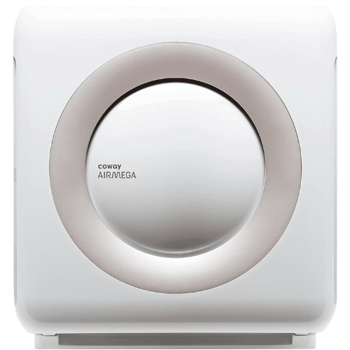
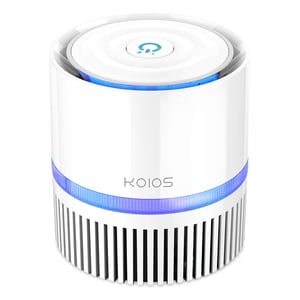 Koios air purifier
Koios air purifier
